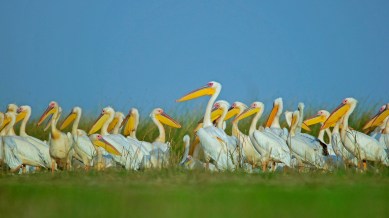Stay updated with the latest - Click here to follow us on Instagram
Around 10 lakh birds counted in Porbandar wetlands, double as compared to last year
Dhaval Vargiya, president of Mokarsagar Wetland Conservation Committee, Porbandar and Gujarat state coordinator of the Asian Waterbird Census, said that this year’s count covered more area of the wetlands. “Particularly, we could cover more area of Mendha Creek and so the number for this wetland has increased,” he said.

Around 10 lakh birds were counted in the wetlands of the Porbandar district during the Porbandar Bird Count 2024 conducted last month, said officials. During the two-day count, conducted on February 3 and 4, as many as 9.69 lakh birds of 223 species were counted in eight major wetlands of the district.
The total count of birds included 9.59 lakh waterbirds of 131 species and around 10,000 birds of terrestrial species, recently released data by the Bird Conservation Society of Gujarat (BCSG) shows. The numbers this year were almost double when compared to the previous year’s total of 5.70 lakh birds.
The bird count was conducted jointly by the BCSG and the Gujarat Forest Department. It was sponsored by the Saurashtra Chemicals Limited of Narmada Group as part of a wildlife management plan it had submitted to get environmental clearance for expansion of its soda-ash manufacturing plant in Porbandar. The 2024 count was the third and the last in this series and included eight wetlands — Mokarsagar, Chhaya, Porbandar Bird Sanctuary, Kuchhadi, Javar, Mendha Creek, Bardasagar and Amipur dam—cumulatively spread over 200 square kilometres.
In the category of wetland birds, the number of cranes was estimated to be the highest during the count. Around 60 birdwatchers who counted the birds estimated crane numbers to be around 3.95 lakh. These were followed by ducks and geese with their numbers pegged at 2.13 lakh. The exercise also has given an estimate of other birds — flamingos (1.94 lakh) gulls and terns (47,325), waders and shorebirds (32,168), rails-coots-and-crakes (31,744) and pelicans (10,991). The birdwatchers also recorded 6,884 ibises and spoonbills, 6148 cormorants, 5566 grebes, 2656 storks, 365 wagtails and pipits, 301 jacanas, 249 kingfishers and 154 raptors.
The bird count almost doubled in Mendha Creek as 6.47 lakh birds were estimated to be in the wetland in February this year against the 3.68 lakh last year. In Bardasagar, the count almost tripled to 56,618 birds this year as compared to 20,830 estimated in 2023. It also soared to 41,504 from merely 889 in Amipur dam, the data shows. The numbers in Mokarsagar remained almost constant at 1.24 lakh as compared to 1.17 lakh last year. The difference in the other four wetlands was also not remarkable.
In the 2023 count, 5.70 lakh waterbirds of 137 species were recorded in Porbandar wetlands. In the 2022 count, more than 3.26 lakh birds of 117 species were recorded. “It is difficult to pinpoint the reason behind the jump in the number of birds in Porbandar wetlands this year as such a phenomenon depends on a variety of factors. The fact that we conducted the count during the peak migration season could be one reason. Amipur dam is under repair and hence it has only dead water in it. This could have diverted birds towards Mendha Creek,” Uday Vora, BCSG honorary secretary who coordinated the 2024 count, said.
Dhaval Vargiya, president of Mokarsagar Wetland Conservation Committee, Porbandar and Gujarat state coordinator of the Asian Waterbird Census, said that this year’s count covered more area of the wetlands. “Particularly, we could cover more area of Mendha Creek and so the number for this wetland has increased,” he said.
Bakul Trivedi, president of BCSG, welcomed the results but suggested that the bird count should not be viewed as an exercise in counting birds only. “Such counts can also or should provide information about the type of habitat and status of habitat. Therefore, such exercises should not be viewed from the angle of bird numbers only. Bird numbers sighted in a wetland can be one aspect of such exercise. However, long-term monitoring of wetlands is needed,” Trivedi said, adding, “Exercises like this provide some baseline data for habitats and raise public awareness about our avia diversity and diverse habitats which is essential for conservation in the long run. It can also promote eco-tourism and create livelihood opportunities for the locals.”